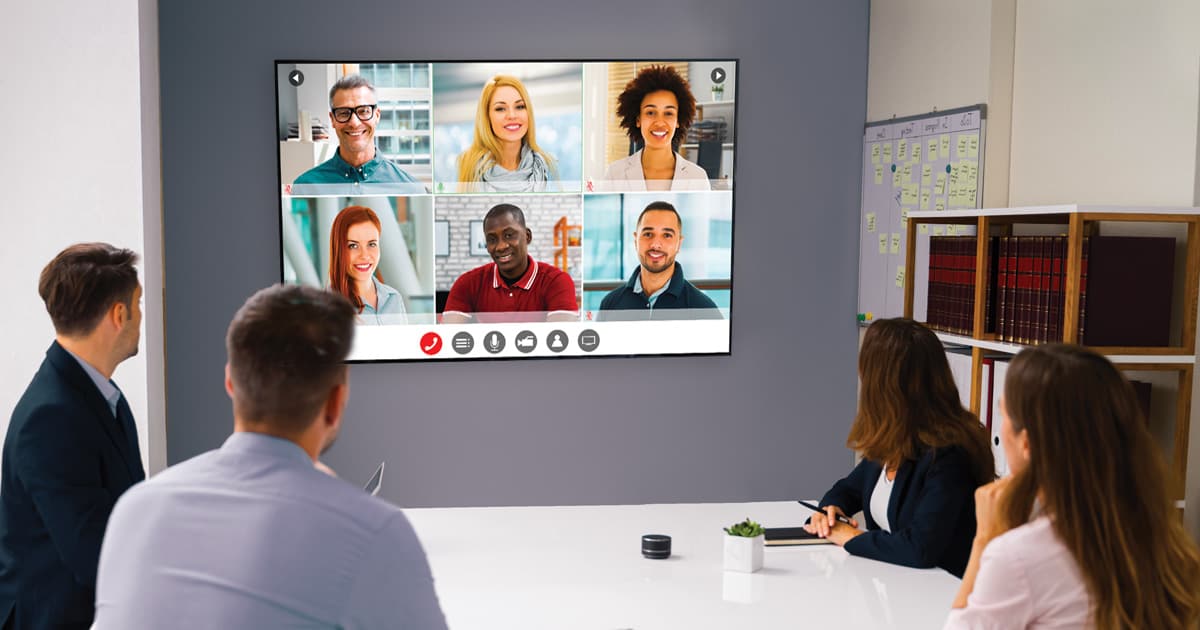By Anne Cosgrove
From the June 2021 Issue
By now, facility executives have been through multiple iterations of planning the “new office” and the features and protocols that define a safe, productive, welcoming workplace for employees and visitors alike. And, each organization is at its own place on the spectrum of reopening after COVID-19 brought occupancy levels to a screeching halt. Some are fully open, others have brought back employees on a staggered schedule, while still more are planning the comeback for this fall. A common thread is that flexibility is key, as it relates to health and safety, space configuration, remote working options, and technology being used to navigate daily and long-term operation.

The broad challenge is the onset of the hybrid workplace—employees working on-site and remotely, and not on schedules identical to each other. Organizations that already had remote working in place were able to adjust more quickly than those to whom off-site working was new; still, the adjustment is across the board, even for those who had some off-site scheduling in place before the pandemic. So, looking ahead, attracting employees back on-site, connecting those who are off-site, and ensuring effective use of facility spaces and overall real estate footprint will be paramount.
“In the hybrid workplace, facility managers will have greater visibility to flex operational demand with tech-enabled tools to support the planning and forecasting of user volumes,” says Cheryl Carron, global operations lead, experience services and facilities management for JLL. “New insights, driven by increased use of sensors and AI, will support the facility manager’s ability to trend utilization and patterns of amenities, space, and resources, and thus create greater value for organizations and their users. The hybrid workplace will work in support of and emphasize the facility manager as integral to understanding what is required to meet the needs of the dynamic hybrid workplace.”
In a new book to be published this summer by the IFMA Foundation, “Work on the Move 3: Building Better Workplaces After the Pandemic,” industry thought leaders have collaborated to provide guidance to facilities professionals. The concepts shared in the book aim to help executives and managers lead their companies through a critical workplace transformation in a post-pandemic world.
Recently, the Foundation released a preview of the book’s “Chapter 2: The Hybrid Workplace, Reimagining the Future of Work After the Pandemic,” authored by Michael Schley, founder of FM:Systems, a technology provider for the workplace; and Pat Turnbull, MA, LEED AP, IFMA Fellow, senior associate at Advanced Workplace Associates. In this chapter, hybrid is defined as “a work model where some employees return to the workplace, others continue to work from home (or other remote locations) and some do both. It is not an ‘all or nothing’ proposition. The hybrid work model is designed with built-in flexibility to boost productivity, as well as employee satisfaction, health, and well-being and to position organizations to accelerate the achievement of business goals. Hybrid work solutions are tailored to meet the unique challenges of each organization—there is no ‘one size fits all’.”
People, Place, And Technology
A March 2021 report from Leesman, “Workplace 2021: Appraising future-readiness,” finds that pre-pandemic, 54% of global employees had little to no experience working from home. London-based Leesman is a world leader in measuring and analyzing employee experiences in their workplace, and for this report began surveying employees around the world, eventually gathering responses from 160,000+ workers.
In its report, Leesman asks: What’s driving employee location preference? Then it asks, “What is the difference between exceptional and average offices? An outstanding workplace supports both the individual and collaborative dimensions of work and doesn’t sacrifice one for the other. While the average home may out-perform offices for the acoustic privacy needed for individual work and conversations, homes fail to support activities that demand collaboration and interaction—even an average office supports these activities better.”
For SpaceIQ, a company providing software solutions that address real estate optimization and forecasting, workplace management and planning, and employee coordination and experience, the hybrid workplace expansion brings forth its focus on technology for workplace stakeholders.
James Franklin, chief customer officer for SpaceIQ, says, “A typical hybrid workplace has a choice in schedule (days in office), in location (assigned, dedicated or open seating), and in space type (space for focus work vs collaboration). Employees are provided with the means to easily find, book, and navigate to the resources they need. While facilities and space planning professionals are given the data and tools needed to properly plan, assign, and manage in a flexible environment.”
Drawing on SpaceIQ’s work with its clients, Franklin continues, “Employees are seeking flexibility and less friction in how they accomplish their work. As every person is unique, so are preferred working styles and schedules. Flexible seating allows individuals to work in the manner of their choosing, whether it be from home, at a coffee shop, in Milan, or in a desk that has their personal effects on it. The hybrid workplace ensures that it is easy for employees to find what they need to be most productive and ensure it is available when they need it.”
The Facility Management Role
Facilities teams have been central in this upheaval and reorganization that’s occurred since early 2020, and this role is not expected to change. As JLL’s Carron observes, “A facility manager’s most critical muscle is their natural ability to multi-task—which had plenty of exercise over the course of the pandemic. Daily, and even hourly, changes to protocol and space guidelines challenged these professionals to divert, pivot, modify, and completely re-write operational plans. However, embracing the unexpected was the result of enhanced development in innovation and critical thinking.

“Equally, resilience became another notable skill,” she continues. “Facility managers were restrategizing plans and determining areas of risk, as they became laser-focused on resiliency beyond the traditional boundaries. This will be an ongoing positive outcome that will benefit the workplace going forward.”
Whether adopting new tech tools or expanding upon existing systems, facilities professionals are also discovering the capabilities of software platforms focused on workplace management.
“The organizations that had the most success had a combination of modern technology, an adaptive culture, and experience with agile approaches to space,” says SpaceIQ’s Franklin. “Such organizations have relied on facility managers to leverage their existing strengths to lead the way on integrating new and innovative technologies into the physical space for improved utilization data, access, navigation, or productivity. Facility managers have also been instrumental in creating a safe environment that gives employees confidence that a return to the office will both productive and comfortable.”
Plan For Action: A Checklist
At the close of its “Workplace 2021: Appraising future-readiness,” Leesman offers a checklist for workplace planners to assess their organization’s future-readiness. This 20-point audit checklist is a reference for any stage of planning. (To download full report, visit LeesmanIndex.com.)
People:
- You understand how the complexity of your employees’ roles vary across the organization (the range of different things they do as part of their role)?
- This has allowed you to determine what proportion of your employees work in individual, collaborative or more blended roles.
- You also established what proportion of your employees are working in specialist or technical roles that require access to technical equipment.
- You understand the nature of the setting each employee has available to them to work at when working from home.
- You have also checked that the hard and soft digital infrastructure is supporting the employee in that home setting.
- You have assessed how your existing corporate workplaces support employee sense of connection to the organization and to their colleagues.
- You understand how well your existing workplaces support an employee’s personal sense of well-being.
- 8. You have identified and now understand the causes for any employees who are struggling with any aspect of remote working.
Place:
- You have measured the extent to which employees have changed work patterns and behaviors and considered how this will impact the spaces they need.
- You have an understanding of how well your existing spaces support those activities for which acoustic privacy is a key feature.
- You have assessed workplace layouts, densities and adjacencies and know how these impact different teams/employee groups in different ways.
- You have assessed the ergonomic characteristics of all the spaces employees use for work, whether in the office, at home or elsewhere.
- Where employees will work from home, you have plans in place to help them create ergonomically safe and supportive environments for themselves there.
- You have appraised the particular role of physical places in supporting collective/ collaborative activities within the different teams within your organization.
- You have analyzed whether the variety of different work settings provided in your workplace and the spaces meets with your team’s needs.
Time:
- Your organization has clearly communicated its high-level post-pandemic workplace location strategy.
- Where these plans allow employees some time / location choice, you have established how you will load balance their time in office and have systems in place to administer.
- You have established what changes will be needed to the physical and digital workplace to align with this strategy and have communications plans to explain what this means for employees.
- Plans are in motion so that the spaces employees return to are ready for their post-pandemic work style.
- Where your plans for workplace changes cannot be implemented prior to employees’ return, your communications clearly describe how soon they will be implemented and available.
Evolution Continues
The COVID-19 pandemic has changed how people work in and out of the office, as well as how facility management teams provide efficient, comfortable workplaces. This will be an ongoing process, as one would expect, with the best solutions varying for each organization. Yet, as workplace professionals continue to implement (or discontinue) strategies to foster a productive environment, the lessons learned are sure to help propel all stakeholders in the coming years.
Cosgrove is Editor-in-Chief of Facility Executive. For more about the organizations included in this article, visit JLL.com; foundation.ifma.org; www.LeesmanIndex.com; and www.SpaceIQ.com.
What changes have you made to the offices you manage as employees return? What practices have stayed the same? Share your experience by sending an e-mail to acosgrove@groupc.com.



















![[VIDEO] Collect Asset Data at the Speed of Walking a Building](https://facilityexecutive.com/wp-content/uploads/2024/02/maxresdefault-324x160.jpg)